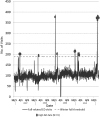Risk of Fall-Related Injury due to Adverse Weather Events, Philadelphia, Pennsylvania, 2006-2011
- PMID: 28692393
- PMCID: PMC5676509
- DOI: 10.1177/0033354917706968
Risk of Fall-Related Injury due to Adverse Weather Events, Philadelphia, Pennsylvania, 2006-2011
Abstract
Objectives: Following a surge in fall-related visits to local hospital emergency departments (EDs) after a severe ice storm, the Philadelphia Department of Public Health examined the association between inclement winter weather events and fall-related ED visits during a 5-year period.
Methods: Using a standardized set of keywords, we identified fall-related injuries in ED chief complaint logs submitted as part of Philadelphia Department of Public Health's syndromic surveillance from December 2006 through March 2011. We compared days when falls exceeded the winter fall threshold (ie, "high-fall days") with control days within the same winter season. We then conducted matched case-control analysis to identify weather and patient characteristics related to increased fall-related ED visits.
Results: Fifteen high-fall days occurred during winter months in the 5-year period. In multivariable analysis, 18- to 64-year-olds were twice as likely to receive ED care for fall-related injuries on high-fall days than on control days. The crude odds of ED visits occurring from 7:00 am to 10:59 am were 70% higher on high-fall days vs control days. Snow was a predictor of a high-fall day: the adjusted odds of snow before a high-fall day as compared with snow before a control day was 13.4.
Conclusions: The association between the number of fall-related ED visits and weather-related fall injuries, age, and timing suggests that many events occurred en route to work in the morning. Promoting work closures or delaying openings after severe winter weather would allow time for better snow or ice removal, and including "fall risk" in winter weather advisories might effectively warn morning commuters. Both strategies could help reduce the number of weather-related fall injuries.
Keywords: falls; syndromic surveillance; weather.
Conflict of interest statement
Figures


References
-
- Centers for Disease Control and Prevention. Be prepared to stay safe and healthy in winter. http://www.cdc.gov/Features/WinterWeather/index.html. Accessed February 13, 2013.
-
- City of Philadelphia. Safety and emergency preparedness: winter weather. https://alpha.phila.gov/natural-hazards/winter-weather. Accessed February 13, 2013.
-
- Lewis LM, Lasater LC. Frequency, distribution, and management of injuries due to an ice storm in a large metropolitan area. South Med J. 1994;87(2):174–178. - PubMed
-
- Piercefield E, Wendling T, Archer P, et al. Winter storm-related injuries in Oklahoma, January 2007. J Safety Res. 2011;42(1):27–32. - PubMed
MeSH terms
LinkOut - more resources
Full Text Sources
Other Literature Sources
Medical
Research Materials

